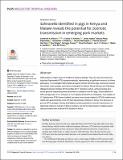| dc.contributor.author | Catherine N. WilsonID1, 2,3☯*, Caisey V. PulfordID1☯, James Akoko4 , Blanca Perez SepulvedaID1 , Alexander V. PredeusID1 , Jessica BevingtonID1 , Patricia Duncan5 , Neil HallID6 , Paul Wigley1 , Nicholas Feasey2,7, Gina Pinchbeck1 , Jay C. D. HintonID1 , Melita A. GordonID1,2, Eric M. FèvreID | |
| dc.description.abstract | Salmonella is a major cause of foodborne disease globally. Pigs can carry and shed nontyphoidal Salmonella (NTS) asymptomatically, representing a significant reservoir for these
pathogens. To investigate Salmonella carriage by African domestic pigs, faecal and mesenteric lymph node samples were taken at slaughter in Nairobi, Busia (Kenya) and Chikwawa
(Malawi) between October 2016 and May 2017. Selective culture, antisera testing and
whole genome sequencing were performed on samples from 647 pigs; the prevalence of
NTS carriage was 12.7% in Busia, 9.1% in Nairobi and 24.6% in Chikwawa. Two isolates of
S. Typhimurium ST313 were isolated, but were more closely related to ST313 isolates associated with gastroenteritis in the UK than bloodstream infection in Africa. The discovery of
porcine NTS carriage in Kenya and Malawi reveals potential for zoonotic transmission of
diarrhoeal strains to humans in these countries, but not for transmission of clades specifically associated with invasive NTS disease in Africa. | en_US |

